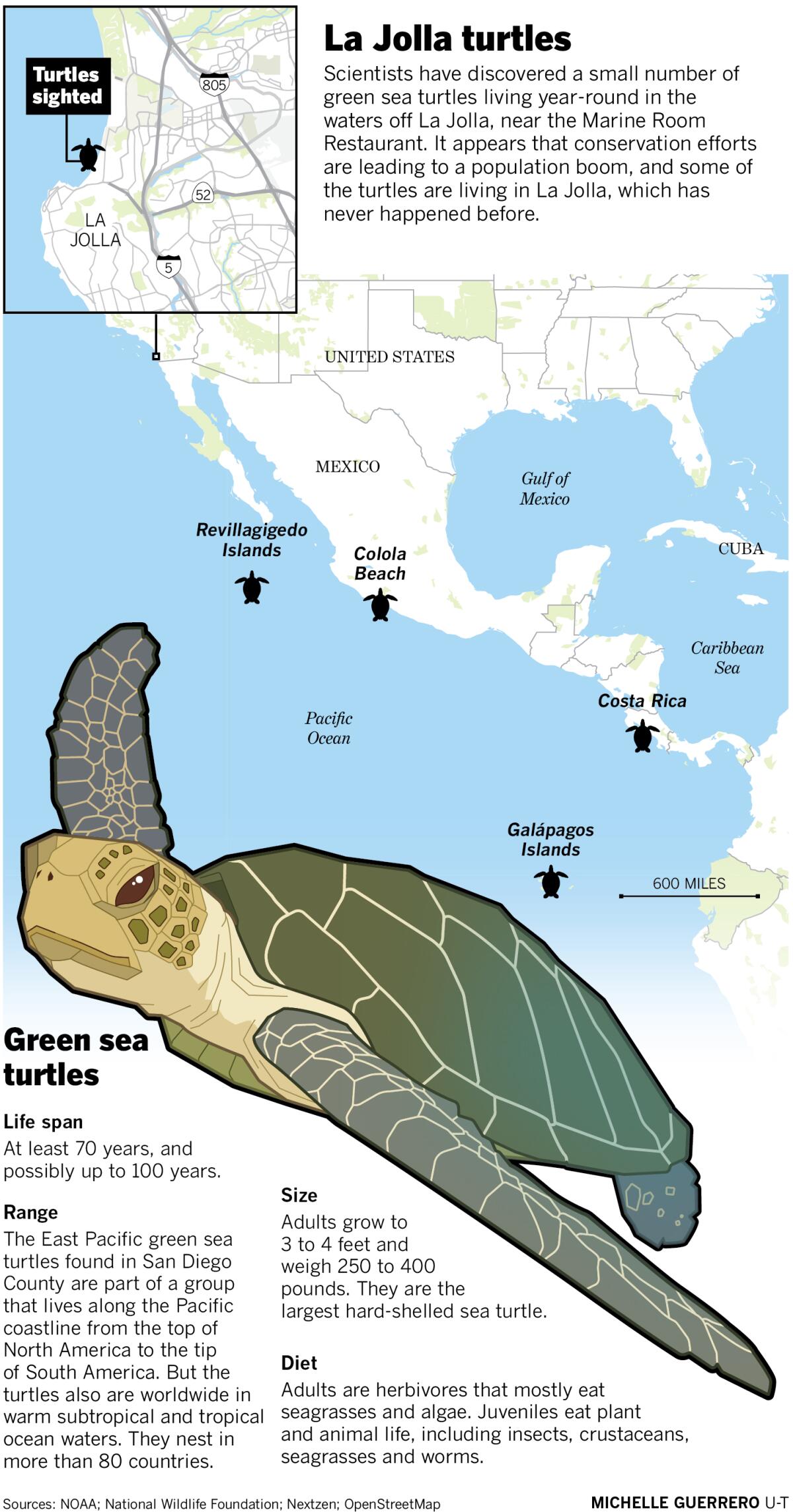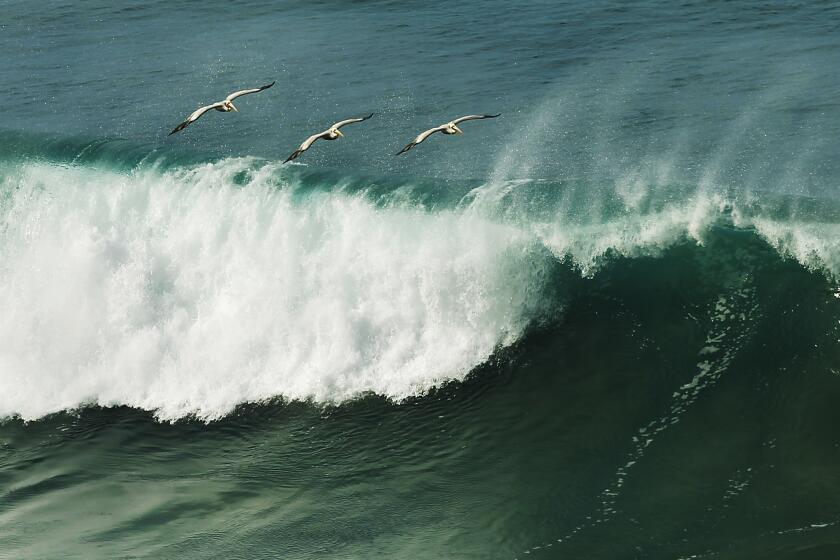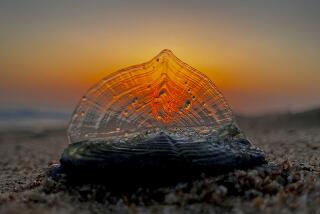Scientists discover ‘eternal’ green sea turtles living year-round off La Jolla

A tiny group of East Pacific green sea turtles has permanently settled in the waters off La Jolla Shores, where they’re socializing with snorkelers and divers, a subtle change in nature that’s left scientists a bit puzzled.
LA JOLLA — A tiny group of East Pacific green sea turtles has permanently settled in the waters off La Jolla Shores, where they’re socializing with snorkelers and divers, a subtle change in nature that’s left scientists a bit puzzled.
The four resident turtles are living in a largely unprotected stretch of coastline, which also is unusual. And they are swimming in water that sometimes gets colder than the reptile’s typical habitat.
“We appear to be seeing the result of 30 years of conservation efforts that has increased the population of green sea turtles, and some are expanding into new territories to forage,” said Megan Hanna, a UC San Diego-trained marine biologist who just published a study on the La Jolla turtles in the journal Frontiers in Marine Science.
Hanna, an environmental analyst for the Navy, produced the study with Jeff Seminoff, a researcher at the National Oceanic and Atmospheric Administration’s Southwest Fisheries Science Center in La Jolla.
“We have long seen these turtles living in spots like San Diego Bay and the Seal Beach National Wildlife Refuge,” Seminoff said. “But they just sort of appeared under our nose here in La Jolla, which is so cool. This speaks to their ability to survive and thrive in diverse habitats.
“There are only four of them now. We think we’re going to see more in the future.”
Divers and snorkelers first began to see the turtles in the waters south of the Marine Room restaurant in 2015. The sightings became more frequent and widespread, catching the attention of Hanna, who at the time was working on her master’s degree at UC San Diego’s Scripps Institution of Oceanography.
She began studying the change with the help of the dive community, which provided her with more than 300 underwater photographs of the turtles taken from 2016 to 2019. Hanna used Hotspotter species recognition software to clearly identify seven turtles, and focused on five that were consistently present during that three-year period. One of the turtles died in the last year, although a new resident may have appeared.
The birds have a fantastic ability to ride invisible updrafts
“I think the turtles are here year-round,” Hanna said. “We have photographic evidence of them being here throughout the seasons. It’s sometimes harder to see them in the winter when the water is really cold. I think they’re undergoing hibernation-type behavior where they’re hunkering down to try to stay warm. It’s a lot harder to encounter them during those times.”
The La Jolla turtles, which appear to be in the 5- to 15-year-old range, were seen foraging in water that was as cold as 60.4 degrees. That’s a degree or two colder than San Diego Bay, where the water is more stagnant.
“That’s a huge difference because every little bit of heat allows certain enzymes to operate,” Seminoff said. “Colder water makes it harder for them to digest food and move around.”
He also was struck by how willing the turtles, which are roughly 2 to 2.5 feet long, are to interact with humans.
“All of the [East Pacific] turtles outside of La Jolla are incredibly afraid of humans,” Seminoff said. “They’ll get away as quickly as they can. What’s happening here is an analogue to Hawaii, where people have memorable vacations swimming with green turtles.
“The ones in La Jolla don’t swim away.”
That’s thrilling for divers, although NOAA notes that the turtles are a protected species and that people should not touch them.

The green turtles found in the warm waters of Hawaii are the same species (Chelonia mydas) as those in the East Pacific, which refers to the Pacific coastal region that extends from the top of North America to the tip of South America.
Hanna says it is possible that the La Jolla turtles have become habituated to divers and snorkelers in the same way that it has happened in Hawaii.
There was a time when the fate of the East Pacific green sea turtle didn’t seem so promising.
In the early 1970s, about 25,000 nesting females could be found at Colola Beach in Michoacan, Mexico, a primary birthing area about 1,500 miles south of San Diego.
The gentle creatures appear return to the same spot in La Jolla once every three years
But by the mid- to late 1980s, that figure had fallen to roughly 150 because so many people were exploiting the creatures for their fat, meat and eggs, NOAA says.
Strict conservation rules imposed by the U.S. and Mexico put the turtles on the path to recovery. About 10,000 females now nest seasonally in Michoacan. And the number is growing.
It is helping to preserve the future of a creature that dazzles divers.
Green sea turtles are graceful swimmers with powerful flippers. They usually poke along at less than 6 mph. But scientists say the turtles can get up to 22 mph — roughly as fast as the average dog can run — when they’re trying to flee a threat.
The turtle’s life span has not been clearly determined, largely because they live longer than most of the scientists who study them. Studies say that can live at least 70 years. And there is evidence that some live to be 90 or even 100.
“These are wondrous creatures that almost seem eternal,” Seminoff said. “They sort of float in the mid-water, moving with the currents and blades of sea grass. They are one of the most beautiful things you can see in the ocean.”
Robbins writes for the San Diego Union-Tribune.
More to Read
Sign up for Essential California
The most important California stories and recommendations in your inbox every morning.
You may occasionally receive promotional content from the Los Angeles Times.









